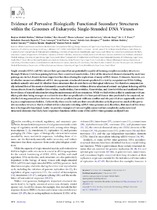| dc.contributor.author | Muhire, Brejnev Muhizi | |
| dc.contributor.author | Golden, Michael | |
| dc.contributor.author | Tanov, Emil Pavlov | |
| dc.contributor.author | Harkins, Gordon William | |
| dc.contributor.author | Murrell, Ben | |
| dc.contributor.author | Lefeuvre, Pierre | |
| dc.contributor.author | Lett, Jean-Michel | |
| dc.contributor.author | Gray, Alistair | |
| dc.contributor.author | Poon, Art Y. F. | |
| dc.contributor.author | Ngandu, Nobubelo Kwanele | |
| dc.contributor.author | Semegni, Yves | |
| dc.contributor.author | Monjane, Adérito Luis | |
| dc.contributor.author | Varsani, Arvind | |
| dc.contributor.author | Shepherd, Dionne Natalie | |
| dc.contributor.author | Martin, Darren Patrick | |
| dc.date.accessioned | 2017-07-12T10:42:08Z | |
| dc.date.available | 2017-07-12T10:42:08Z | |
| dc.date.issued | 2013 | |
| dc.identifier.citation | Muhire, B. M. et al. (2013). Evidence of pervasive biologically functional secondary structures within the Genomes of Eukaryotic Single-Stranded DNA Viruses. Journal of Virology, 88 (4): 1972–1989 | en_US |
| dc.identifier.issn | 0022-538X | |
| dc.identifier.uri | http://hdl.handle.net/10566/3062 | |
| dc.description.abstract | Single-stranded DNA (ssDNA) viruses have genomes that are potentially capable of forming complex secondary structures
through Watson-Crick base pairing between their constituent nucleotides. A few of the structural elements formed by such base
pairings are, in fact, known to have important functions during the replication of many ssDNA viruses. Unknown, however, are
(i) whether numerous additional ssDNA virus genomic structural elements predicted to exist by computational DNA folding
methods actually exist and (ii) whether those structures that do exist have any biological relevance. We therefore computationally
inferred lists of the most evolutionarily conserved structures within a diverse selection of animal- and plant-infecting ssDNA
viruses drawn from the families Circoviridae, Anelloviridae, Parvoviridae, Nanoviridae, and Geminiviridae and analyzed these
for evidence of natural selection favoring the maintenance of these structures. While we find evidence that is consistent with purifying
selection being stronger at nucleotide sites that are predicted to be base paired than at sites predicted to be unpaired, we
also find strong associations between sites that are predicted to pair with one another and site pairs that are apparently coevolving
in a complementary fashion. Collectively, these results indicate that natural selection actively preserves much of the pervasive
secondary structure that is evident within eukaryote-infecting ssDNA virus genomes and, therefore, that much of this structure
is biologically functional. Lastly, we provide examples of various highly conserved but completely uncharacterized
structural elements that likely have important functions within some of the ssDNA virus genomes analyzed here. | en_US |
| dc.language.iso | en | en_US |
| dc.publisher | American Society for Microbiology | en_US |
| dc.rights | Publisher retains copyright. Authors may archive the published version in their institutional repository. | |
| dc.source.uri | http://dx.doi.org/10.1128/JVI.03031-13 | |
| dc.subject | Evidence | en_US |
| dc.subject | Single-stranded DNA | en_US |
| dc.subject | Genomes of Eukaryotic Single-Stranded DNA Viruses | en_US |
| dc.subject | Pervasive Biologically Functional Secondary Structures | en_US |
| dc.title | Evidence of pervasive biologically functional secondary structures within the Genomes of Eukaryotic Single-Stranded DNA Viruses | en_US |
| dc.type | Article | en_US |
| dc.description.accreditation | Department of HE and Training approved list | |

